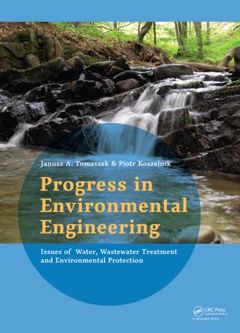Progress in Environmental Engineering Water, Wastewater Treatment and Environmental Protection Issues
Coordonnateurs : Tomaszek Janusz, Koszelnik Piotr

Progress in Environmental Engineering contains theoretical and experimental contributions on water purification, new concepts andmethods of wastewater treatment, and ecological problems in freshwater ecosystems. The issues dealt with in the book include:
(i) Causes and control of activated sludge bulking and foaming
(ii) e use of new support materials in activated sludge technology as a result of studies on wastewater treatment in a sequencing batch reactor with keramsite grains as the porous carrier in Moving Bed Sequencing Batch Biofi lm Reactors
(iii) Greenhouse gas emissions from WWTPs especially mechanisms of N2O production in biological wastewater treatment under nitrifying and denitrifying conditions and strategies to mitigate N2O emissions from biological nitrogen removal systems as well as spatiotemporal variation of nitrous oxide emissions from reservoirs (
iv) Novel techniques of water protection against eutrophication and reclamation, in particular aspects of chemical methods of reclamation e.g. using lime for the inactivation of phosphate
(v) A method for risk management in water distribution system operation and maintenance using Bayesian process. e proposed method makes it possible to estimate the risks associated with the possibility of partial or total loss of the ability of water supply system operation.
Progress in Environmental Engineering includes unique contributions to understand selected aspects of environmental protection and proposes methods to eff ectively solve pollution problems. The book will be of interest to academia and professionals interested or involved in environmental engineering.
Janusz A. Tomaszek and Piotr Koszelnik, Department of Environmental & Chemistry Engineering, Rzeszów University of Technology, Rzeszów, Poland.
Date de parution : 03-2015
17.4x24.6 cm
Disponible chez l'éditeur (délai d'approvisionnement : 14 jours).
Prix indicatif 80,97 €
Ajouter au panierThème de Progress in Environmental Engineering :
Mots-clés :
Activated Sludge; activated; Bottom Sediments; sludge; WWTP; sequence; N2O Emission; batch; Sludge Bulking; reactors; Filamentous Bacteria; wastewater; Cod Removal; treatment; Activated Sludge Bulking; biological; Influence Cod; bottom; Cod Loading Rate; sediments; Microthrix Parvicella; Tp Ratio; Nitrifier Denitrification; Risk Analysis; Sequencing Batch Reactor; N2O Production; Industrial Waste Landfill; Filamentous Microorganisms; Cochran Cox Test; Lacustrine Zone; Bayesian Network; High Finesse Optical Cavities; Zinc Lead Ores; Hydroxylamine Oxidation; Heterotrophic Denitrification


